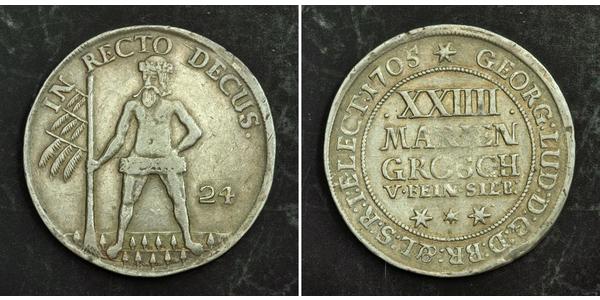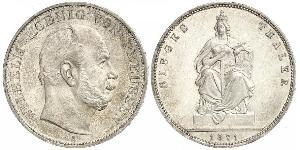2/3 Thaler / 1 Gulden / 24 Mariengroschen (sold for $79.0)
1705, Brunswick-Luneburg-Calenberg-Hannover, George Louis. Silver 24 Mariengroschen (Gulden) Coin. He was both Duke of Hanover and King of England!
Mint Year: 1705 Mint Place: Zellerfeld Reference: Davenport 423, Welter 2158, KM-15. Denomination: Gulden (24 Mariengroschen = 2/3 Thaler) Condition: Scattered contact-marks and a few edge-nicks, otherwise about XF! Weight: 13.01gm Diameter: 36mm Material: Silver
Obverse:Standing half-naked wildman (woodwose), bending a tree to his right. Value (24) to his left. Tiny trees below, motto above. Legend: IN RECTO DECUS ("Honor in doing right!") Reverse: Value (*XXIIII*) above denomination (MARIEN GROSCH) and fractional silver mark value (V.FEIN.SILB) above privy mark (***). Legend: * GEORG : LUD : D : G : D : BR : & L : S : R : I : ELECT : 1705 .
The wild man or woodwose is a mythological figure that appears in the artwork and literature of medieval Europe. Images of wild men appear in the carved and painted roof bosses where intersecting ogee vaults meet in the Canterbury Cathedral, in positions where one is also likely to encounter the vegetal Green Man. The wild man, pilosus or "hairy all over," and often armed with a club, was a link between civilized humans and the dangerous elf-like spirits of natural woodland, such as Puck. The image of the wild man survived to appear as supporter for heraldic coats-of-arms, especially in Germany, well into the 16th century. Early engravers in Germany and Italy were particularly fond of wild men, wild women, and wild families, with examples from Martin Schongauer and Albrecht Dürer among others.
The earliest medieval concepts of the wild man focus on him as a normal human gone wild by madness, as in the Biblical story of Nebuchadnezzar; this first occurs in Celtic societies in the High Middle Ages. These Celtic stories attribute to the wild man poetic or prophetic powers. The 9th-century Irish tale Buile Shuibhne (The Madness of Sweeney) describes how Sweeney, the pagan king of the Dál nAraidi in Ulster, assaults the Christian bishop Ronan Finn and is cursed with madness as a result. He spends many years traveling naked through the woods, where he composes verse. The Welsh told a similar story about Myrddin Wyllt, the origin of the Merlin of later romance. In these stories Myrddin is a warrior in the service of King Gwenddoleu ap Ceidio at the time of the Battle of Arfderydd. When his lord is killed at the battle, Myrddin takes to the Caledonian Forest in a fit of madness which bestows him with the ability to compose prophetic poetry; a number of later prophetic poems are attributed to him. The Life of Saint Kentigern includes almost the same story, though here the madman of Arfderydd is instead called Lailoken, which may be the original name. The fragmentary 16th-century Breton text An Dialog Etre Arzur Roe D'an Bretounet Ha Guynglaff (Dialog Between Arthur and Guynglaff) tells of a meeting between King Arthur and the wild man Guynglaff, who predicts events which will occur down to the 16th century.
The House of Hanover (the Hanoverians) is a Germanic royal dynasty which has ruled the Duchy of Brunswick-Lüneburg (German: Braunschweig-Lüneburg), the Kingdom of Hanover and the Kingdom of Great Britain and the Kingdom of Ireland. It succeeded the House of Stuart as monarchs of Great Britain and Ireland in 1714 and held that office until the death of Victoria in 1901. They are sometimes referred to as the House of Brunswick and Lüneburg, Hanover line. The House of Hanover is a younger branch of the House of Welf, which in turn is the senior branch of the House of Este, with all three being offshoots of the ancient Saxon House of Wettin.
Queen Victoria was the granddaughter of George III, and was a descendant of most major European royal houses. She arranged marriages for her children and grandchildren across the continent, tying Europe together; this earned her the nickname "the grandmother of Europe." She was the last British monarch of the House of Hanover; her son King Edward VII belonged to the House of Saxe-Coburg and Gotha since she could not inherit the German kingdom and duchies under Salic law. Those possessions passed to the next eligible male heir, her uncle Ernest Augustus I of Hanover, the Duke of Cumberland and Teviotdale—the fifth son of George III. In the United Kingdom, after World War I, King George V changed the house's name from Saxe-Coburg and Gotha to the currently serving House of Windsor in 1917. Both dynastic names are offshoots of the 800-plus years old House of Wettin.
George I (George Louis; German: Georg Ludwig; 28 May 1660 – 11 June 1727) was King of Great Britain and Ireland from 1 August 1714 until his death, and ruler of the Duchy and Electorate of Brunswick-Lüneburg (Hanover) in the Holy Roman Empire from 1698.
George was born in Hanover, in what is now Germany, and inherited the titles and lands of the Duchy of Brunswick-Lüneburg from his father and uncles. A succession of European wars expanded his German domains during his lifetime, and in 1708 he was ratified as prince-elector of Hanover. At the age of 54, after the death of Queen Anne of Great Britain, George ascended the British throne as the first monarch of the House of Hanover. Although over fifty Roman Catholics bore closer blood relationships to Anne, the Act of Settlement 1701 prohibited Catholics from inheriting the British throne. George, however, was Anne's closest living Protestant relative. In reaction, Jacobites attempted to depose George and replace him with Anne's Catholic half-brother, James Francis Edward Stuart, but their attempts failed.
During George's reign, the powers of the monarchy diminished and Britain began a transition to the modern system of cabinet government led by a prime minister. Towards the end of his reign, actual power was held by Sir Robert Walpole, Britain's first de facto prime minister. George died on a trip to his native Hanover, where he was buried.

|
Posted by:
anonymous 2016-12-14 |
|
||
|
||
|
||
|
||
2 Lira Kingdom of Italy (1861-1946) Silver Vittorio Emanuele ...
group has 18 coins / 14 prices
⇑
2 Ban Romanian Principalities (1859-1881) Copper
group has 4 coins / 3 prices
⇑




 Deutsch
Deutsch Русский
Русский Українська
Українська English
English Italiano
Italiano Français
Français Español
Español 汉语
汉语





-300-150-_QkKbzbiMk0AAAFNEbxtvw0E.jpg)

-300-150-DRaBwfuWkloAAAGLv51rgHlM.jpg)






